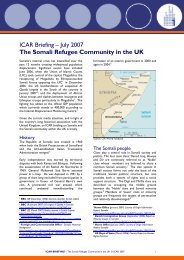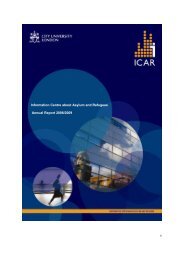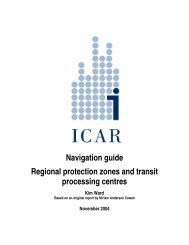Uncovered: assessing media and communications needs ... - ICAR
Uncovered: assessing media and communications needs ... - ICAR
Uncovered: assessing media and communications needs ... - ICAR
- No tags were found...
You also want an ePaper? Increase the reach of your titles
YUMPU automatically turns print PDFs into web optimized ePapers that Google loves.
6 RECOMMENDATIONSTraining <strong>needs</strong> <strong>and</strong> capacity in the sectors involved in this research are bound up with more thanthe simple design of content <strong>and</strong> forms of delivery. Other issues to be taken into account includehow to identify <strong>and</strong> contact grass roots organisations <strong>and</strong> the presentation <strong>and</strong> ethos of trainingopportunities. Therefore in drawing up these recommendations suggestions have been includedabout effective ways of targeting <strong>and</strong> attracting key groups.The initial tranche of courses for these target groups should focus on the basic rationale <strong>and</strong> skillsneeded to create an appetite for the subject. We would also add that it is important when targetingservices at specifi c groups to bear in mind the impact on others who may be feeling equallymarginalised, for example other groups in deprived neighbourhoods who may feel their voice is notbeing heard. The researchers recommend that any efforts to deliver training to the people identifi ed inthis survey should take into account the likely parallel <strong>needs</strong> of those other groups.We suggest national <strong>media</strong> <strong>and</strong> communication training providers <strong>and</strong> support agencies such asMedia Trust consider the following:6.1 Engage with the <strong>media</strong>• Engage local <strong>media</strong> representatives in planning training strategy• include local <strong>media</strong> (where relevant) in training delivery• Discuss with the <strong>media</strong> ways of addressing perceived under-representation <strong>and</strong> misrepresentationof minority groups6.2 Engage with local infrastructure <strong>and</strong> support organisations• To help plan courses in regional centres appropriate to target groups• To advise about appropriate time, duration <strong>and</strong> practical requirements• Consider including sector representatives in delivery team• Consider the potential of cascading training <strong>and</strong> advocacy – from umbrella organisations tomember groups or from individuals to colleagues6.3 Design training courses on:• It’s good to talk – underst<strong>and</strong>ing the importance of a <strong>communications</strong> strategy in the whole contextof an organisation’s work, including its relevance to issues such as securing funding, attractingvolunteers <strong>and</strong> infl uencing policy• Taking on the <strong>media</strong> – an introduction to how the <strong>media</strong> works; how ordinary people can connectwith it; how to exploit its uses <strong>and</strong> challenge its abuses; its relevance to attracting funding <strong>and</strong> otheraspects of an organisation’s work• Framing the message – underst<strong>and</strong>ing journalists <strong>and</strong> how they work; how to adapt messages fordifferent audiences• Controlling your image – confi dence-building to help people conquer their fears of <strong>media</strong> <strong>and</strong>publicity, including interview practice• When journalists come knocking – how to prepare yourself for being thrust into the spotlight• How to get seen <strong>and</strong> heard – the most effective ways of publicising your activities, attractingvolunteers, clients <strong>and</strong> funders42 <strong>Uncovered</strong>: <strong>assessing</strong> <strong>media</strong> <strong>and</strong> <strong>communications</strong> <strong>needs</strong> <strong>and</strong> capacity of marginalised communities
















